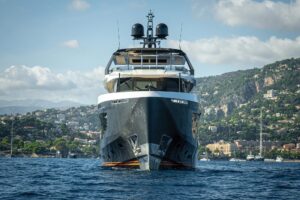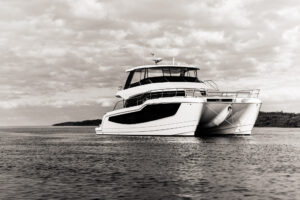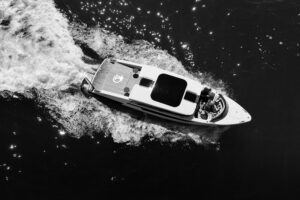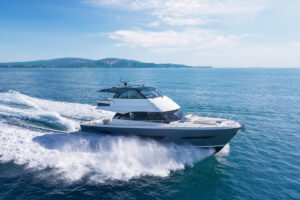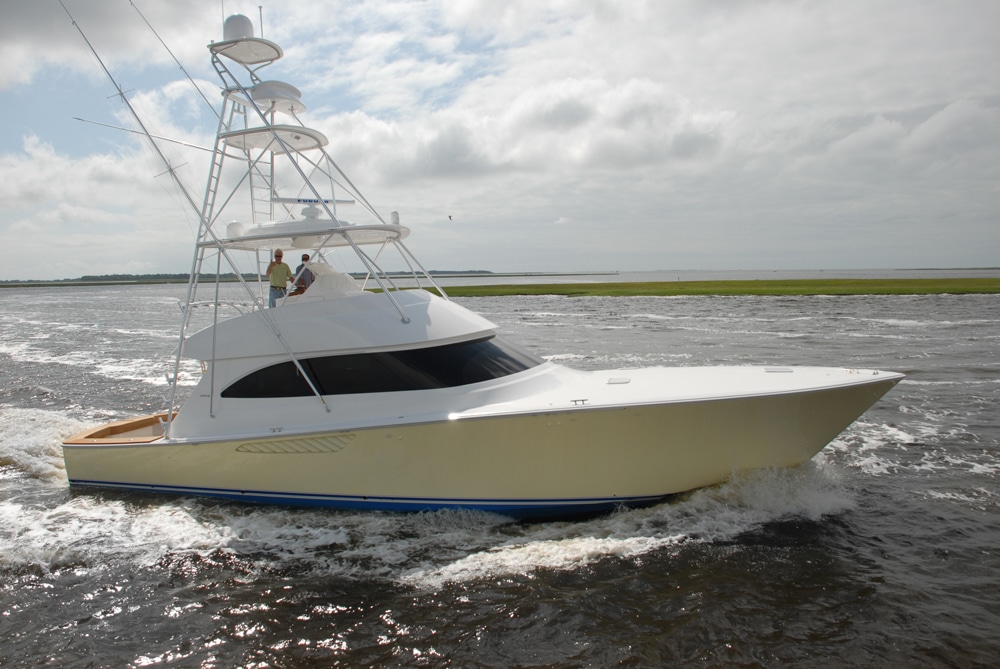
Viking 55 Convertible
The proud bow of Viking’s 55 Convertible pierced the outer edge of Atlantic City, New Jersey’s Absecon Inlet and entered into a near-flat-calm ocean. She was pointed east and I got the sense that this sport-fisherman wanted to bolt straightway for the distant canyons in search of novel-worthy pelagics that could easily span her 17-foot-9-inch beam. I know it’s what I wanted her to do. After all, this vessel is named Business (hull No. 1) and creating big-game boats is what this builder is all about.
This sport-fisherman is constructed to handle the rigors of such offshore duty. Her vacuum-infused, Baltek-core hull — except for where there are through-hull penetrations, which are solid fiberglass — sports a planing form that follows that of her predecessors, the Viking 60 and 70. (Vacuum infusion is also used on numerous other parts of this yacht for weight savings. All totaled, the 55 comes in at a 77,700-pound, full-load displacement, which is lighter than most in her class.)
Unlike earlier Vikings, this hull form features amplified convex sections forward and aft that help with head-sea performance and enhance stability in a seaway, roll movement on the drift or trolling and lift when throttling up. In addition, two small strakes add to her effortless planing ability.
A raised sheer line above the waterline complements my test boat’s enhanced shape beneath it. The result is increased forward freeboard, which should keep most spray at bay and ensure that the flying bridge’s optional Costa Clear enclosure is relatively salt-free when Poseidon gets an attitude (as he is known to do).
_Click here to see a full photo gallery of the Viking 55 Convertible._
Where this boat truly shines is when she’s pushing herself to the ragged edge of performance. During my wheel time, I took the twin ZF single-lever controls and flattened them to the pins. The optional 1,550-horsepower MAN 12-cylinder diesels quickly spooled up in sweet synchronicity at 2,330 rpm, which is well within the 2,300 rpm rating, as the 55 shot in the direction of those calling canyons. (MAN 1,400 hp diesels are standard, and 1,800 hp MANs and 1,625 hp Caterpillar C32s are also options.) I checked the center 17-inch screen of this boat’s three-display electronics setup, featuring the optional Furuno NavNet 3D system, and noted the speed on the GPS: 42 knots!
This velocity created an awesome blow-what-hair-I-have-left breeze that any helmsman would welcome as a wake-up greeting or for cooling off after a long day of trolling for those pugnacious pointy-nose fish that big-game anglers love to chase. That speed will cost, however, about 160 gph.
Dialing back her engines to 1,900 rpm set this test boat at a comfortable 33.5-knot cruise while the MANs burned 100 gph. At this pace, this 55 has a range of 488 nautical miles or 0.34 nmpg based on her 1,619-gallon fuel capacity and a 10 percent reserve. (My test vessel featured an optional 205-gallon tank, which is positioned under the companionway stairs leading belowdecks.) At 1,700 rpm those MANs go through 76 gph, reduce the boat’s speed to a quite-respectable 29 knots and extend that range to 556 nautical miles. In addition, this setting keeps the engine load in the low- to mid-60 percent realm, helping ensure that your vessel’s power plants have a long and healthy run.
Although this model doesn’t feature the fly-by-wire Viking independent programmable electro-hydraulic rudder (VIPER) steering system of her larger siblings, she’s no less agile with her power-assisted tie-bar setup, which has offset tiller arms to enable fast response and quick cuts. I put the wheel hard over while she made 36 knots and this 55-footer carved a near-perfect, three-boat-length circle into the sea while feeling sure-footed throughout the maneuver. This yacht’s pedigree was also evident in her ability to effortlessly spin on her axis and back down with a vengeance. Tournament anglers will really appreciate her agility.
They will also appreciate this yacht’s 151 square feet of fish-fighting cockpit space as well as the two massive in-sole fish boxes under the optional teak-covered cockpit that are both capable of holding several bigeyes. Of course, these boxes can also be set up as a dump for the ice maker (as on this vessel) and livewells, or any combination of the three. There’s also an in-transom kill box. Like that cockpit sole, the 55 sports optional all-teak covering boards.
Finishing off the business side of this boat is a pair of Rupp outriggers, a contoured and artisanal-grade Release Marine offset fighting chair set up for battling granders and a mezzanine with built-in bait stowage under the seat.
The same attention to detail given to the 55’s construction and fishability can be found in this sport-fisherman’s interior spaces. This test vessel sported grain-matched, high-gloss teak veneer throughout her interior. Attractive teak strips set up against the salon’s cream-tone headliner subtly, but effectively, play off the overhead LED lighting, adding a sense of warmth to this space.
The 55’s starboard-side island galley layout with an Amtico rosewood-tone sole sported two stools at the overhanging countertop, offering a great place for breakfast. Four under-counter, drawer-style Sub-Zeros (two refrigerators, two freezers) offer plenty of room for stores for the traveling angler and his team for a week or more. If you prefer, you can lose the island and extend the galley counter outboard to starboard, which gains you two more drawers under it. (This 55 got extra freezer space by placing a unit on the flying bridge in lieu of the standard sink.)
A four-burner electric cooktop makes meal preparation for the crew a breeze, but when the bite is hot and time is limited, the Sharp Carousel microwave makes reheating that oh-so-tasty Hot Pocket a no-brainer. (You know you eat them.)
Deep pullout cabinet drawers offer sizable stowage space for dry goods, paper products and snacks. Worthy of note is the light feel of the galley’s cabinet doors, which are cored with Nomex honeycomb in yet another weight-saving measure. All latches and catches here are robust, and even when running the 55 at wide-open throttle up and over boat wakes, not one door or drawer popped open.
Form and function really meld well on this sport-fisherman, and this is illustrated in the belowdecks layout, which features a starboard-side master stateroom with en suite head. Eye-catching arched doors define the hanging locker here while a dresser sits just forward of the queen-size berth. Additional stowage is found in myriad drawers along the outboard side of the room and in two end tables that flank the berth.
Guests and/or crew can take refuge after a long day of battling big fish in either the portside guest space with side-by-side berths or the forepeak VIP, which on this 55 featured crossover berths — a great arrangement for the hard-core angler and his team. For the straight-up cruiser or cruiser-gentleman angler, you can also get a step-up island queen berth here.
In 1996 Viking Yachts launched its first 55-footer. It was the post-luxury-tax world, and over a five-year period this builder constructed and sold about 150 of them. A lot has been learned over the course of building so many boats, and it shows in the new 55. This wealth of experience, combined with innovations in today’s hull design, build methods and technologies, makes it easy to predict that the Viking 55 will be a winner all over again.
LOA: 56’5″
Beam: 17’9″
Draft: 5’1″
Displ.: 77,700 lb.
Fuel: 1,414 gal.
Water: 225 gal.
Engines (tested): 2 x 1,550 hp MAN diesels
Engines (standard): 2 x 1,400 hp MAN diesels
Base Price: $2,259,000
Price (as tested): $2,932,176
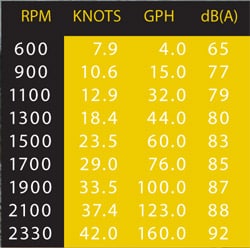
Test Conditions: Speeds were measured by GPS in the waters off Atlantic City, New Jersey, in calm seas and 5 to 10 knots of wind, with full fuel and water and four people aboard. Fuel consumption was calculated by the electronic engine-monitoring system. Sound levels were measured at the helm.
Viking Yachts, 609-296-6000; vikingyachts.com

